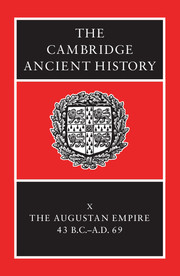8 - The Imperial finances
from PART II - THE GOVERNMENT AND ADMINISTRATION OF THE EMPIRE
Published online by Cambridge University Press: 28 March 2008
Summary
The economic resources at the disposal of the emperors from Augustus to Vitellius and the uses which they made of them are most clearly explained against the background of the state expenditure of the Roman empire.
The empire required an army, and under Augustus a standing army was developed, of which the size and terms of service of the legionary component remained broadly stable throughout this period, although the nature of the auxiliary component took much longer to crystallize. Annual pay for a legionary was 900 sesterces, while cavalrymen, higher ranks and the praetorian guard received considerably more. There were stoppages against this pay for replacement equipment and clothing and almost certainly for food. On discharge a surviving legionary in theory received a bounty of 12,000 sesterces – equivalent to over twelve years' basic pay, and so a third of a surviving veteran's total remuneration – but he may often have been given a plot of land in a frontier zone instead or in part payment. The conversion of auxiliary forces, traditionally supplied ad hoc by allied states, into regular units of the Roman army and the standardization of their terms of service and remuneration were slow processes which lasted into the Flavian era. The rate of pay for auxiliary troops remains frustratingly uncertain (footsoldiers may have received a half or five-sixths or some intermediate fraction of the basic legionary rate), as does the date of its standardization (perhaps under Claudius, but perhaps not until the Flavians).
- Type
- Chapter
- Information
- The Cambridge Ancient History , pp. 309 - 323Publisher: Cambridge University PressPrint publication year: 1996
References
- 8
- Cited by



